
(Photo from Timberland Singapore)
Yesterday, it rained for most of the day, making our pruning of poplars a cooling and enjoyable (if somewhat wet) experience. While it meant that we didn't end up baking and getting burnt to a crisp, I was somewhat hoping that the weather would change, and we would get to experience the desert. After all, deserts are defined by low amounts of precipitation; it would be ironic (and disappointing) if we ended up spending our days here in the Horqin Desert getting soaked in the rain.
Today, we finally found out what it was truly like being out in the desert. I'm just hoping that I don't suffer too much from this sunburn.
In many ways, this was the most important day of the entire trip, and the whole reason why we were traipsing around Inner Mongolia in the first place. The main activity for the day was to plant eight hundred pine saplings in an area of desert in the Agula region, helping to restore the vegetation that once covered this land not too long ago.
Once again, we got up bright and early, and boarded the buses. Alas, Chee Fan had fallen ill the night before, and had to pull out of the trip and return to Singapore. A most unfortunate turn of events, and all of us in the Singapore contingent will miss having him with us.

(Photo by Sharon Cheah)
Sheryl recounted how she had killed a large cricket that she'd found on her bed, but I was surprised by the photo that Sharon showed me: a house centipede (F. Scutigeridae) that happened to be occupying her room. The Singaporean representatives of this family tend to live in the forests, but a few other species in temperate regions have become commensals of humans, entering buildings and feeding on smaller inhabitants such as cockroaches and spiders. One species in particular (Scutigera coleoptrata) was formerly native to the Mediterranean area, but thanks to its habit of hanging out close to and within our dwellings, has since managed to tag along and colonise many other parts of the world. Like all other centipedes, house centipedes have venom and can give painful bites, but these are not life-threatening. Otherwise, these creepy-crawlies are quite harmless, and do a great service in preying upon pests. Still, seeing one scuttling about can be a frightening experience.

Damn, why can't I have something like this in my room? The small cricket in my bathroom pales in comparison.
(Photo by colbugspotter)
Anyway, I digress.
We had been told that it was going to be a long ride, but we didn't quite expect what happened.
Have you ever sat in a bus that was trying too hard to be a Land Rover? The bus ride proved to be quite a harrowing experience. Many of us dozed off, but we were soon rudely shaken awake as the bus jolted and jerked, throwing us about as if we were dice. I for one was woken up when I thumped my head against the window.
The bus had gone off the asphalt road, and was now travelling down a rough dirt track, one that was perhaps more suited to four wheel drive vehicles or beasts of burden. Here's a video to show you just how rough the terrain was for our vehicle. Note that no deliberate shaking of my camera was involved, just me holding my camera against the headrest of the seat in front in a futile effort to stabilise it.
While we were being tossed about like salad, I had to admit that the view outside was nice.

Finally, after around 2 hours of this nausea and head trauma-inducing bus ride, we arrived at a rest stop, where we could all go for a toilet break. It was also where we would transfer to a different mode of transportation, as the rest of the road was far too rough even for the buses.



Jervis and I amused ourselves for a while with trying to take proper photos of these barn swallows (Hirundo rustica). They had built their mud nests beneath the eaves of the building, and a group was also perched on the wires nearby.

(Photo by Jervis Mun)



A friend of mine is fond of sunflowers, so these photos are for her.


The sunflowers attracted a few hoverflies (F. Syrphidae). Often mistaken for bees, adult hoverflies are completely harmless, and are often seen visiting flowers for nectar. It is said that the superficially bee-like appearance of many hoverfly species helps ward off predators, which might think twice before attacking stinging insects.


These insects however pack a real sting. Oh yes, yet another wasp nest that I found in the nearby pine trees.


Here's a small wolf spider (F. Lycosidae). The white thing beneath her abdomen is actually the mother wolf spider's egg sac, which she attaches to her spinnerets and carries around while she's out hunting. When the eggs hatch, the spiderlings gather on their mother's abdomen and hang on, continuing to gain some protection. Only after the young have grown a little larger do they leave their mother and wander off to fend for themselves.

I could run off into the fields and forests and spend an entire day chasing insects and spiders.

(Photo by Malaysia Asia)
Apparently, using the toilets was not exactly a very pleasurable experience. Here's Malaysian celebrity Aishah Sinclair, all smiles before bravely venturing inside. As much as I am curious as to how disgusting it was inside, based on the horrifying descriptions by my companions, I'm deciding that ignorance is bliss.

(Photo by Malaysia Asia)
And here's Aishah showing the interior of the portable toilet that we brought along. Me? I decided to duck behind a random shrub.
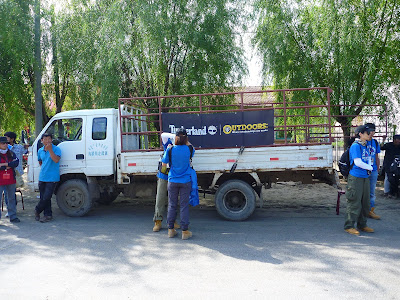
It turned out that we would be making the rest of the journey in these trucks, which were designed to carry domestic livestock such as cattle and sheep. Indeed, over the past few days, we'd already seen quite a few of these vehicles, laden with cattle.




And so we were herded (literally) onto these trucks, with the Singaporean contingent sharing space with the group from Hong Kong. As the gate to the pen was closed and secured, we were instructed to just grab the bars and hang on for dear life. The bars are well and truly rusted, and the slightest touch leaves orange stains and flakes on clothes and skin. The floor of the pen looked clean, and there weren't any of the odours one would associate with livestock, but considering the sort of cargo it usually carries, I'm fairly sure that there had to be some residual animal dung stuck somewhere on the corrugated surface. Even so, everyone was still in high spirits, chatting and taking photos.

(Photo from Timberland Singapore)
I'm deliberately pretending that I'm not in high spirits.


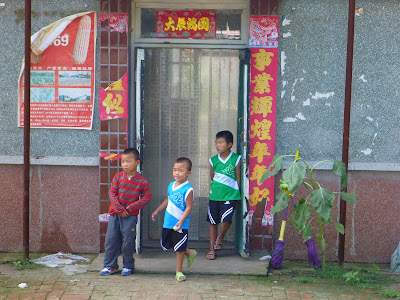
Random, but the local children are quite adorable.
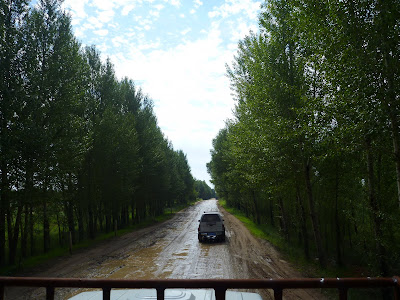
If I'd thought that the bus ride was frightening, the cattle trucks provided a whole new level of trauma. The road proved to consist of nothing but kilometres of dirt track, a mixture of sand, soil and bits of gravel, and in parts where rainwater had accumulated, a thick brownish mud. As the trucks rattled along, the bars of the pen trembled. I tried taking photos here and there, but the crowded conditions and the bars of the truck meant that most of the time, I was just raising my camera above head level, blindly shooting away, hoping that the next jolt wouldn't send the camera sailing out of my hands. Most of my photos turned out to be unusable.





A sign painted on a wall. "生男生女,一样好" loosely translates to "Giving birth to boys or girls is equally good". I suppose it's something to do with the unintended consequences of China's population management strategies, combined with an age-old preference for sons over daughters.
One thing I noticed, but didn't manage to photograph, was the large quantity of rubbish that was snagged on the wire fences. The sad fact is that proper waste disposal is still quite unheard of in this part of the world, and even in the uninhabited areas, one could find stretches where the fences were literally decorated with the remnants of plastic bags, flapping about in the wind. It does ruin the beauty of the place, and I wonder if there are any possible environmental impacts, as the plastic bags slowly disintegrate and leach chemicals into the soil.




As we continued to make our way down the dirt road, the forests and woodlands soon gave way to grasslands, mixed in with bare sand dunes and desert scrub. Many of these appeared to be agricultural areas, with herds of cattle, sheep, and horses grazing away, or vast fields of sunflowers and cereals. We passed by small farmhouses, with vegetable plots and chickens in the yard. Some of these also had rows of small trees, probably the result of reforestation efforts.

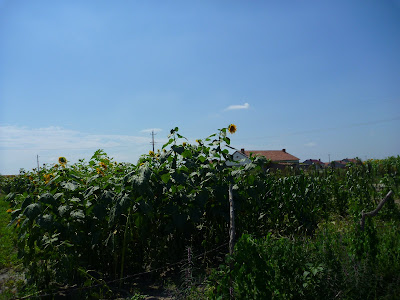

We did see quite a fair bit of wildlife. Once in a while, we saw small rodents scurrying beside or even across the road, in front of the convoy; these were most probably Daurian ground squirrels (Spermophilus dauricus), a species that has still managed to thrive for now despite the habitat destruction and hunting that has wiped out many of the mammals of the steppes.

Daurian ground squirrels;
(Photo taken from sendakingcat's blog)
As for the birds, we got excellent views of several species, although it was impossible to take photos; while I'd only had a fleeting glimpse of Korean magpies (Pica sericea) yesterday, this time around, I saw several pairs that were foraging on the ground. In the agricultural areas, we saw large numbers of a crow-like bird with a slaty-grey bill, which I think are rooks (Corvus frugilegus), as well as a somewhat smaller corvid, which I think are Daurian jackdaws (Coloeus dauuricus).

Korean magpie;
(Photo by Hauzen)
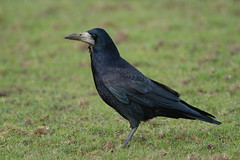

Left: Rook;
(Photo by m. geven)
Right: Daurian jackdaw;
(Photo by Hiyashi Haka)

Rooks in a field;
(Photo by gynti_46)
This photo wasn't taken in Inner Mongolia, but many of the birds we saw were behaving exactly like this, sitting in a field in small flocks or in pairs, often in close proximity to grazing livestock. My guess is that they were waiting for prey such as insects to be flushed out by the grazers, or possibly waiting to pick apart piles of dung in search of insects like flies and beetles.

In a pasture, pools of water had formed, creating a gathering place for several white gulls. My guess is that these are immature relict gulls (Ichthyaetus relictus), since adults have black heads during the summer breeding season. Contrary to popular belief, gulls aren't exclusively birds of marine areas, as there are a number of species that breed in wetlands far from the coast, such as in freshwater marshes and saline lakes.

Juvenile relict gull;
(Photo by solfugl)
After some time, we ended up travelling along the shore of what seemed to be a vast shallow lake, and I saw many small waders. It made me wonder if these are birds building up their fat stores before undertaking their annual migration to warmer climes. Perhaps some of them even visit Singapore, stopping over to feed and rest in mangroves and mudflat areas at Sungei Buloh, Mandai, or Changi. I wasn't able to identify most of them (I'm terrible at telling the different species of shorebirds apart), but a few were sufficiently distinctive for me to look up my reference books on birds and note the presence of several pairs of black-winged stilt (Himantopus himantopus) and grey-headed lapwing (Microsarcops cinereus).
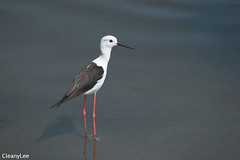
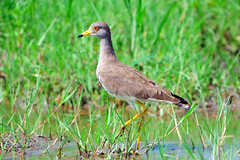
Left: Black-winged stilt;
(Photo by cleanylee)
Right: Grey-headed lapwing;
(Photo by nkenji)
We took a detour and stopped at a place where Timberland had planted poplar saplings just a few years back.

(Photo from Timberland Singapore)




The poplars are still rather small and spindly, and the area doesn't really look like a forest. However, given enough time, they'll mature into tall trees, much like those we pruned yesterday.


(Photo from Timberland Singapore)
Further down, we stopped at another area where trees had been planted several years back, also thanks to help from Timberland. This time around, the dominant trees were pines.

The pine trees are in the background. This was supposed to be a quick stop, and we didn't want to travel too far on foot.


The species of pine we were planting (didn't manage to find out the exact species name) are apparently native to the region, and according to the guide, more suitable for planting in arid areas, since they require less water to grow compared to poplars. Indeed, in a region where a regular supply of groundwater can be a scarce and highly valuable resource, planting too many trees or planting the wrong type of tree in the wrong sort of terrain can place undue stress on the environment, causing a drop in the water table in an already thirsty land. Tree planting may look glamorous and makes for a good public relations exercise, but it's not feasible everywhere, and can create unnecessary negative consequences if carried out without proper research on the local environment.
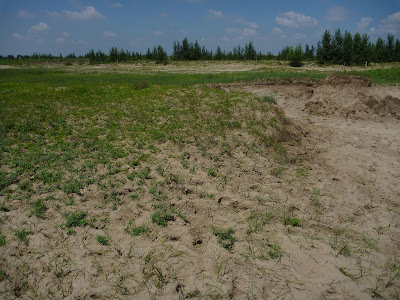
Even grass can have a tough time growing in the loose, dry soil. Overgrazing and trampling, whether by livestock, people, or vehicles, can further reduce the ability of plants to colonise and gain a foothold.

Here are Yoshio Kitaura, the managing director of Japanese NGO Green Network, and Robert Igabille, a member of Timberland's own Global Stewards programme, sharing with us how the planting of trees has helped to slow down the spread of desert in Horqin.

I wonder if this burrow is occupied, and if so, what sort of critter might be hiding inside.


(Photos by Jervis)



We continued with our journey, and passed more herds of livestock.



(Photos by Malaysia Asia)
Our journey continued, and finally, after an hour, we reached our destination, a village that seemed to consist of little more than a scattering of farmhouses, with a town hall that looked like it had just been constructed.


Here's a small grasshopper I found right next to the entrance to the town hall.



Some of us spent a bit of time getting acquainted with the locals. It's strange, but yes, us urban folks don't really get many opportunities to get close to domestic livestock.

This horse, which was roaming about and grazing, eventually got tired of all the photographers, and galloped off. It's at such close quarters that you realise just how powerful and potentially dangerous a horse can be, which is why I cautiously kept my distance.

After today, I now know how to tell horse dung apart from (literal) bullshit.


Lunch was simple but filling. I know the presentation isn't exactly that fantastic, but I was hungry, and I'm no food blogger.

(Photo from Timberland Singapore)


After lunch, we had an extra treat: slices of really fresh, juicy, and sweet watermelons, among the best I've ever tasted. It was turning out to be a really hot and sunny day.




We set off on foot towards the nearby desert, where land had been set aside for the planting of pine saplings. As we walked through the village, we took the chance to take more photos of the domestic animals we encountered.

(Photo by Jervis)



It was not long before I reached the desert proper.



There's a lot more greenery than one might expect from more conventional portrayals of deserts. The vegetation here is composed of desert scrub, consisting of a mixture of prickly shrubs and bushes, with tough grasses and herbs, mixed in with some young pines and poplars that had been planted in previous years.



My ability to identify plants is lousy, so I'm not even going to attempt to identify the ones pictured here.



At least I know that these prickly plants are thistles. You should never attempt to touch them with bare hands, or walk through a patch of thistles if you are wearing shorts.

Here's a pine sapling that had been planted previously, and seemed to be growing well.
As usual, I was on the lookout for whatever native wildlife could be found living here. Most of the insects I saw were small nondescript beetles and ants.

I believe this is an eleven-spot ladybird beetle (Coccinella undecimpunctata).

Darkling beetles (F. Tenebrionidae) were quite common, and much to my frustration, wouldn't stop moving.



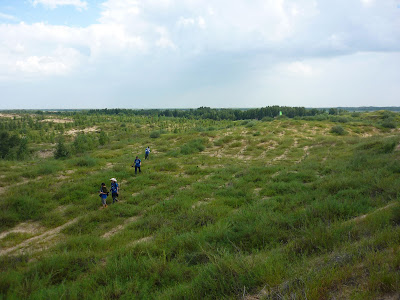

Since we were in the desert, it was most definitely very hot and dry. There was little shade to be found, except beneath scraggly pine trees or in the shadows of the dunes. Every once in a while, whenever the wind picked up speed, we would feel the sting of sand grains against our skin. Still, perhaps because of the low humidity, I did not really suffer much from the heat; in fact, I dare say that I was much more comfortable compared to say, a typical hot and sunny day in Singapore. The fact that the low humidity and strong wind quickly dried up all perspiration probably played a factor. But in such an environment, there is a real risk of dehydration and heatstroke, so I made sure that I had plenty of water with me, as well as lip balm to prevent chapped lips.
At the same time, it's clear how the growth of trees and other plants does slow the effects of desertification. Where the pines and poplars have managed to survive and grow, whether through deliberate human effort or natural propagation and reproduction, the temperature is discernibly cooler, and through the stabilising action of the roots, grasses and shrubs adapted to these xeric (desert) habitats have been able to establish themselves as well. It would be interesting to observe the process of succession over the decades, and in the absence of human intervention, to see whether the woodland remains, or if the grasses eventually reclaim the area and transform the land back into the original grassland.
We had to walk a bit more, and so we trekked through the scrub, looking out for the flags that had been planted at intervals to guide us. To stand at the top of a dune and look at the desert all around you is a breathtaking experience; in Singapore, you almost never get the chance to have an unbroken, all-round view that stretches all the way to the horizon. It's humbling, and also very sobering, when you realise just how vast some of these landscapes are, and yet how we have still managed to damage them through poor land management practices.



(Photo from Timberland Singapore)
A team of locals had already demarcated the boundaries of the plot and marked out the rows. In each row, shallow holes had already been dug at regular intervals, and a pine sapling placed on the ground alongside, indicating that these were the spots to carry on digging and plant the saplings. Robert and Mr. Kitaura carried out a briefing and demonstrated the entire process, and soon we were divided into teams, and further split up into pairs.




Aishah demonstrates the entire process.

(Photo by Arthur Ang)

(Photo by David Fuhrmann-Lim)


(Photo by Jervis)
We were accompanied by this horse, which was standing on top of a small dune, watching the proceedings.
Together with Lilian from Malaysia, I began the arduous task of shoveling the soil, which largely consisted of very fine and dry sand. The deeper one dug, the more moisture there was in the ground, but one could see very clearly how challenging it was for plants to flourish here.


(Photos from Timberland Singapore)


I lost count of the number of saplings we planted, but as we made slow yet steady progress along the row, it gave me an immense sense of satisfaction to see the fruit of our efforts. Elsewhere in the grid, others were doing the same, digging holes, planting saplings, or carefully burying the saplings' roots with sand. Cheryl, a seasoned veteran who had done this twice before, managed to plant an impressive number of saplings on her own.


Here's one of the pine saplings that I planted.
I was surprised when it was soon announced that due to our collective effort, we had planted all eight hundred saplings. A celebratory whoop and cheer rose among the crowd, and we took a short water break, in preparation for the next stage of our activities.

Here's another darkling beetle.

A little caterpillar crawled onto my water bottle in search of some moisture.
Naturally, in these semi-arid climates, the mortality rate of saplings can be high. Water is especially precious here, and humans and livestock definitely have priority where it comes to deciding who gets the largest share of this limited resource. As such, it is impossible to tend to the entire plot of saplings on a daily basis, watering and fertilising them. The locals do carry out pruning and watering, but they can't possibly spend all their waking hours seeing to the needs of every single sapling. Instead, they are pretty much left to their own devices, with the hope that enough trees will survive to have the intended positive impacts on the soil and local microclimate. Still, it doesn't hurt to give the saplings a little drink as a headstart, and this was what we were about to do.

All seventy of us stood in a line, shoulder to shoulder, directly alongside one of the planted rows. When the signal was given, small buckets were filled with water and quickly passed down the line. As buckets changed hands, great coordination and cooperation was required to ensure that buckets weren't dropped and that precious water wasn't spilled and wasted. Everyone started to give shouts of encouragement, with the people at the far end asking the rest to hurry up and pass the buckets along. When there were sufficient buckets of water (one full bucket of water for each sapling), it was time to water the saplings, gently pouring the water into the holes. It was now clear why we didn't have to fill up the entire hole with sand once the young trees had been planted; this way, most of the water could seep downwards directly towards the roots.


(At this point, I'm wondering where the water came from in the first place; I think there was a well with a pump of some sort, since the buckets were filled using a long hose.)

(Photo by Arthur Ang)

And so, we did this for every row of saplings we had planted, taking up our positions and even taking turns to snap photos as the buckets were passed along.


Here's some photos of Jervis in action.


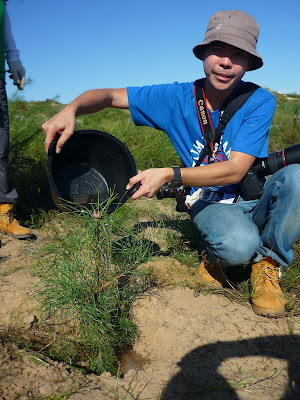
More photos, this time of Jervis and Cheryl.
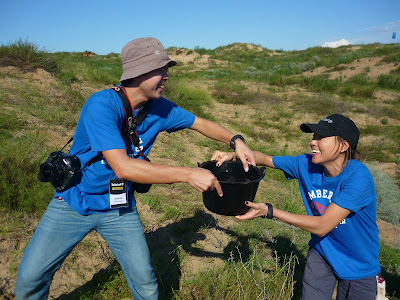






The water immediately seeps through the dry soil. It's not much, but we hope that it'll help the saplings survive in a harsh and unforgiving environment. Not all will live long enough to grow tall and strong, but with some care from the locals and other volunteers working with Green Network and the companies it collaborates with, perhaps we'll see the day when this land is lush and verdant once again.
Thanks to everyone's combined efforts, we were able to finish watering all the saplings, and once again a round of applause and cheering rose from the crowd. Everybody was elated at having achieved the task of planting and watering eight hundred pine saplings in just a few hours, and I did feel pleased that I had played a small part in the restoration of this land.


(Photo by Jervis)

(Photo from Timberland Singapore)
Of course, we had the obligatory group photo.



As we headed back, I couldn't help but notice a small heap of trash in the desert, presumably left by someone from the village. Sigh.


It turned out that the horse that was watching us plant and water the saplings was actually pulling the cart that had transported some essential supplies from the village, such as the buckets and shovels.



After most of the group had gone on ahead, I heard snorting and bellowing, and it was coming nearer. Soon enough, a small herd of cattle appeared, presumably returning to their pen after a day's grazing. Upon seeing me, the cow at the front turned her head and snorted, signalling to the rest of the herd to stop. This same cow, which I guess is the herd leader, continued to stand guard and watch us from a distance. For urbanites, who are probably more used to seeing cattle portrayed as dim-witted and placid barnyard animals, seeing such behaviour more reminiscent of wild animals can be absolutely fascinating.

(Photo by Jervis)

When we returned to where the cattle trucks had been parked, we had a reward waiting for us: frozen popsicles. Yeah, I know that there's a sarcastic remark to be made about food safety standards in China, but hey, it's just what I needed.


(Photo by Jervis)
We were herded onto the cattle trucks once again, and I think most of us were simply tired, as we all sat on the floor of the truck beds and dozed off, while the trucks rumbled and rattled back to where the buses were parked.

Try to find the grasshopper in this photo.
This time around, the buses travelled at a more leisurely pace, and the ride wasn't so bumpy.



We headed back to the hotel, where we rested for a bit and washed up (and I discovered just how badly sunburnt I was), before gathering again for dinner. Once again, there was much food, drink, and merrymaking, and we all had a jolly time.



The final item was a little song performed by a group of local Mongolian singers, supposedly as a way to wish us a safe journey on the next leg of our adventure. They went from table to table, personally offering a cup of liquor to everyone. This is the so-called baijiu (白酒), way more potent than vodka. Only after one had emptied his or her cup would the band move on to the next person. Naturally, I had 2 cups.


The girls who were singing were quite pretty, but alas, the photos I took with my camera turned out blurry. Damn.



(Photos from Timberland Singapore)
And so we've accomplished the main aim of this trip: to contribute in our own way towards fighting desertification in this corner of Inner Mongolia. I'm glad that Timberland Singapore gave me this opportunity to experience a part of the world I would ordinarily not be so keen to explore in my own capacity, and to witness the challenges of environmental protection and restoration in a place very different from Singapore.
In some way, I was hoping that I could have been involved in even more activities. I remember saying to Cheryl that even after spending an afternoon planting and watering saplings, I felt as if I still had plenty of energy and motivation to plant even more. But I guess there are several things to consider: not everyone is as well-adjusted to the outdoors as I am, and any further strenuous activities might be too much for them. We all already knew that a lot of time would be spent on the road; we could cut down on that area by camping in the desert, but not everyone would find that idea very appealing. And of course, there was the fact that it had rained so much the day before. If it had been as hot and sunny as today, I'm sure most of us would probably have ended up quite drained after an entire day of pruning poplars and weaving straw nets.
Our time in Inner Mongolia may be drawing to a close, but our journey hasn't ended yet. Tomorrow, we're crossing the entire country, leaving behind the wind-swept grassy steppes and sand dunes on the outskirts of the Gobi, and heading towards the mist-shrouded mountains and forests at the edge of the Tibetan Plateau. I know I haven't really focused much on this phase of the trip, but I'm getting quite excited to visit places like Jiuzhaigou and Huanglong. From the land of the Mongolian gazelle, we're about to venture into the realm of the giant panda.